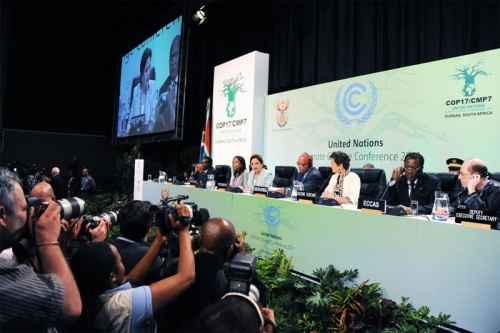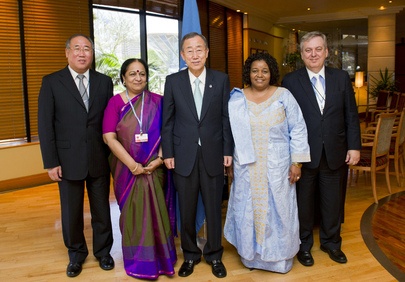

Less than was needed but probably more than we could have expected. When the talks started most of us could see the writing on the wall – the growing polluters as China and India along with US pushing for nothing binding while the smaller states particularly island states, EU and the NGOs seeking immediate commitments in order to meet a goal of keeping carbon emissions down and thus global temperature rises to 2^Centigrade. (Read: - “ Durban Conference Dims Environment Prospects” -
diplomaticallyincorrect.org/films/blog_post/durban-conference-dims-environment-prospects-by-ambassador-mo/42095 ).
Another “Roadmap”?
The European Union in particular pushed the talks as they run 2 days beyond original schedule to adopt a “Roadmap.” In areas where legally binding commitments where not achievable and/or substantive funding was lacking, the idea was to establish a quasi binding patchwork of commitments that would get us to 2020. Think this strategy is one reason while UNSG Secretary General is more optimistic: “Taken together, these agreements represent an important advance in our work on climate change…quickly implement these decisions and to continue working together in the constructive spirit evident in Durban.” (Another agreement called a Roadmap and we can only hope that it is more effective in delivering on climate control than what has been achieved on peace in the Middle East or Somalia “roadmaps”)
What Concrete Results Have Been Achieved?
The good news is that it looks like very much on paper. The bad news is that nuances, enforcement and follow through really do not allow us to yet judge what it all means or how it will transform in effectiveness in achieving desired goals:
---Climate Change Fund has been established (presumably with $60 billion goal), but still very little has been done to raise the required moneys or even agreement on the methodology. Read: - “How to Fund/Manage Green Climate Fund (Private or Public Sector)?” -
diplomaticallyincorrect.org/films/blog_post/how-to-fundmanage-green-climate-private-or-public-sector-by-ambassador-mo/42507;
---Kyoto Protocol was extended until 2013, (as effectively a substitute for lack of other formal binding commitment. Mr. Ban assessed this: “increase certainty for the carbon market and provide additional incentives for new investments in technology and the infrastructure necessary to fight climate change.” However, India, China and US have been deeming themselves not bound;
---Non-binding Commitment on Emissions – most countries continue to be committed to voluntary guidelines until 2020 (beyond binding commitments of Kyoto Protocol);
---Binding Commitment on Emissions – the now so-called “Durban Platform” establishes the roadmap – although it might more resemble “a stairway to carbon emission heaven.” There is at least a two-stop process – reaching legally binding agreements on paper by 2015 and then actual implementation occurring only in 2020. Problem is that by 2020, the globe may be on the Roadmap but already on the road to exceeding the 2^Centigrade goal – Read: - “Warmest Decade Ever” -
diplomaticallyincorrect.org/films/blog_post/warmest-decade-ever-by-ambassador-mo/42151
---“Technology Mechanism” and related anticipated mobilization/coordination in effecting reforms through technology where summarized by UNSG Ban in that he was gratified “that countries reached decisions to implement the Cancun Agreements, which were created at last year's conference in Mexico. The new measures include setting up a Technology Mechanism that will promote access by developing countries to clean, low-carbon technologies, and establishing an Adaptation Committee that will coordinate adaptation activities on a global scale.”
---Deforestation as key to counter carbon emissions – Program to incentivize saving rather than cutting down forests known as “Reducing Emissions from Degradation and Deforestation (REDD)” has barely moved forward in Durban - countries could not agree on funding. According to analysis from The UK “Telegraph”: “There are concerns that money from carbon markets could make it too corrupt and that indigenous people will be pushed out. However REDD remains on the table and will be developed over the next few years as part of the new deal alongside rules in the Kyoto Protocol to stop deforestation.” – For now deforestation remains a labor of love and somewhat successful for NGOs and young people: Read – “The Green Baton is Passed” -
diplomaticallyincorrect.org/films/blog_post/the-green-baton-is-passed-by-susan-sacirbey/42497
Next Steps on the “Roadmap” or Stairway?
UNFCCC meeting will continue next year in Qatar – presumably the next priority will be defining and reaching agreement on the 2015 legally binding commitment including the kind of targets each country will sign up to. The other mechanism available will be another extension of Kyoto and/or some other form of voluntary agreements. We will also be able to evaluate regarding success of the Climate Change Fund, Technology Mechanism and REDD – Read: (Read: - Pilot Indonesia Program Links Deforestation – Carbon Emissions” -
diplomaticallyincorrect.org/films/blog_post/pilot-indonesia-program-links-deforestation-carbon-emission-by-ambassador-mo/41940),
Blocking Progress:
The US was not particularly helpful in Durban, but let China and India do most of the obstruction. With US Presidential elections scheduled for November 2012, the character of the US position could move sharply regressive or become more openly progressive, depending on who is elected next US President. It is China and India (with increasingly BRICK coalition as whole taking more of coordinating role) that were most evident “villains” according to the “Telegraph.” China’s representative resorted to screaming back at the pressure for change and proclaiming himself as standing up for “climate justice.”
“India emerged as the villains, after Jayanthi Natarajan, India’s Environment Minister, refused to sign up a deal that would commit the developing world to a strong legal treaty. She was backed by China, who also seemed reluctant to cut carbon at home. However although the protests by the world’s second and third biggest carbon emitters claimed their concerns are based on "climate justice". They argue that they need to carry on emitting carbon to bring millions of people out of poverty over the next few decades. The US was unusually quiet throughout the talks, but as the world’s biggest emitter made it clear they were also happy with a weak legal outcome.” From Telegraph.
Bottom "UN Photo" of "Villains" Being Pressed by UNSG? - "Secretary-General Meets BASIC Representatives in Durban
Secretary-General Ban Ki-moon (centre) meets with representatives of the BASIC group of developing countries on the sidelines of the COP17/CMP7 UN Climate Change Conference in Durban, South Africa. From left: Xie Zhenhua, Vice Chairman of the National Development and Reform Commission of China; Jayanthi Natarajan, Minister for Environment and Forests of India; Edna Molewa, Minister of Water and Environmental Affairs of South Africa; and Luiz Alberto Figueiredo, Director of Environment and Special Themes in Brazil’s Ministry of External Affairs".
Closing the “Gigatonne Gap”:
This represents the best scientific estimate of how much more carbon emissions need to be cut versus what is actually occurring in order to meet the goal of limiting the temperature rise to 2^Centigrade – now estimated still at 6 tons shortfall in reductions.
Louise Gray at the Telegraph has done a comprehensive and I think very good job of summarizing the Durban talks – Link -
www.telegraph.co.uk/earth/environment/climatechange/8949099/Durban-climate-change-the-agreement-explained.html
By Ambassador Muhamed Sacirbey
Facebook-Become a Fan at “Diplomatically Incorrect”
Twitter – Follow us at DiplomaticallyX
ECOLOGY-DIPLOMAT Channel -
diplomaticallyincorrect.org/c/ecology-diplomat



